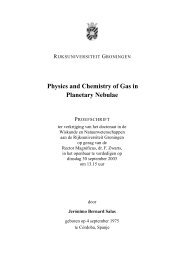TRACING ABUNDANCES IN GALAXIES WITH THE SPITZER ...
TRACING ABUNDANCES IN GALAXIES WITH THE SPITZER ...
TRACING ABUNDANCES IN GALAXIES WITH THE SPITZER ...
You also want an ePaper? Increase the reach of your titles
YUMPU automatically turns print PDFs into web optimized ePapers that Google loves.
of these beautiful objects. Recent references on which this discussion about them<br />
is based are: Pottasch (1984), Osterbrock (1989), and Bernard-Salas (2003).<br />
The blown off outer layers of a star form the gas cloud of a planetary nebula.<br />
This low density (∼10 2 –10 4 cm −3 ) gas is illuminated by a low to intermediate<br />
mass (∼1–8 M⊙) hot (T∗ ∼ 3×10 4 –2×10 5 K) central star which is evolving quickly<br />
towards a white-dwarf. The nebula expands at ∼100 km sec −1 , and as it expands<br />
the density and emission decrease, so that they become unobservable in a few<br />
ten thousand years. Most PNe have a higher ionization level of elements than<br />
H II regions due to the higher temperatures of their central stars, but the lower-<br />
ionization PNe have similar spectra to H II regions. PNe can have many shapes<br />
and are observed in our Galaxy and nearby galaxies. They are concentrated in the<br />
Galactic plane and the center of the Galaxy.<br />
PNe have strong forbidden lines in their spectra, which may be employed to<br />
derive abundances, as discussed in §1.3.3. A series of dredge-up events that occur<br />
as the central star evolves bring the products of nucleosynthesis from the core<br />
of the star (such as helium, carbon, and nitrogen) to the surface of the star.<br />
Additionally, for stars more massive than ∼4–4.5 M⊙, hot bottom burning leads<br />
to the production of elements in nuclear processing at the bottom of the convective<br />
envelope of the star. Stellar winds then push the outer envelope of the star out<br />
into the interstellar medium. Measuring the abundances of these elements in the<br />
PN then gives information about the nucleosynthesis processes inside the star.<br />
However, the abundances of elements not affected by nucleosynthesis in the central<br />
star (such as argon, neon, and sulfur) give information about the initial composition<br />
of the cloud from which the star formed, and thus about the chemical evolution of<br />
the interstellar medium at the time that the star formed. Abundances from PNe<br />
across the Galaxy give information about the chemical evolution of the Galaxy as<br />
11













